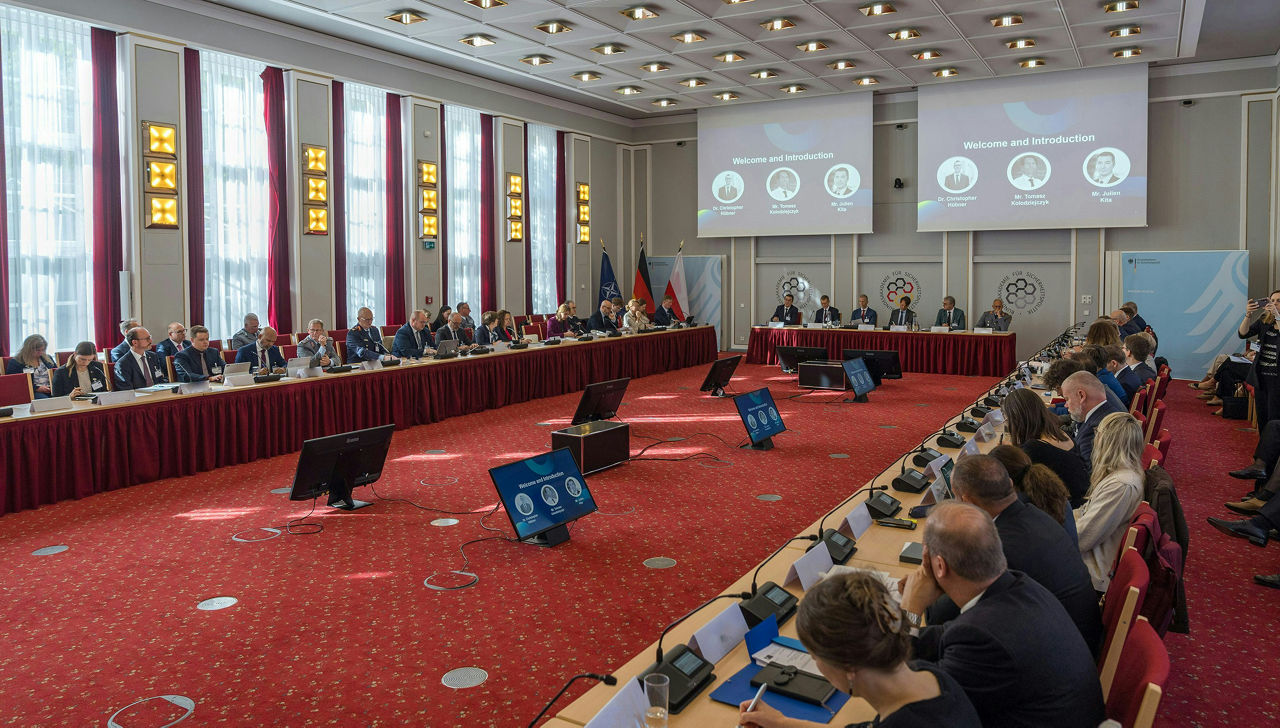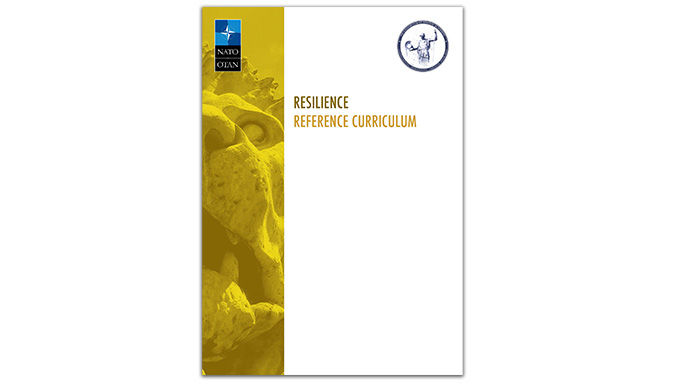Download NATO’s broadcast-quality video content free of charge

Log in
NATO MULTIMEDIA ACCOUNT
Access NATO’s broadcast-quality video content free of charge

Check your inbox and enter verification code
You have successfully created your account
From now on you can download videos from our website
Subscribe to our newsletter
If you would also like to subscribe to the newsletter and receive our latest updates, click on the button below.
Enter the email address you registered with and we will send you a code to reset your password.
Didn't receive a code? Send new Code
The password must be at least 12 characters long, no spaces, include upper/lowercase letters, numbers and symbols.
Your password has been updated
Click the button to return to the page you were on and log in with your new password.
Resilience, civil preparedness and Article 3
Updated: 13 November 2024
Each NATO member country needs to be resilient in order to withstand a major shock such as a natural disaster, failure of critical infrastructure, or a hybrid or armed attack. Resilience is the individual and collective capacity to prepare for, resist, respond to and quickly recover from shocks and disruptions, and to ensure the continuity of the Alliance’s activities. Civil preparedness is a central pillar of Allies’ resilience and a critical enabler for the Alliance’s collective defence, and NATO supports Allies in assessing and enhancing their civil preparedness. Rooted in Article 3 of the North Atlantic Treaty, national and collective resilience are an essential basis for credible deterrence and defence, and are therefore vital to NATO’s efforts to safeguard its societies, populations and shared values.
- The principle of resilience is rooted in Article 3 of the North Atlantic Treaty: “In order more effectively to achieve the objectives of this Treaty, the Parties, separately and jointly, by means of continuous and effective self-help and mutual aid, will maintain and develop their individual and collective capacity to resist armed attack.”
- Article 3 helps to give NATO the means to fulfil its core tasks, particularly that of deterrence and defence.
- Resilience is both a national responsibility and a collective commitment. Each Ally needs to be sufficiently prepared and adaptable to deal with the entire spectrum of crises envisaged by the Alliance. At the same time, the individual commitment of every Ally to maintain and strengthen its resilience reduces the vulnerability of NATO as a whole.
- Military efforts to defend NATO territory and populations need to be complemented by robust civil preparedness to reduce potential vulnerabilities and the risk of attack in peacetime, crisis and conflict.
- Civil preparedness has three core functions: continuity of government, continuity of essential services to the population and civil support to military operations. These critical specifications have been translated into seven baseline requirements for national resilience against which Allies can measure their levels of preparedness.
- Military forces, especially those deployed during crises and conflict, depend heavily on the civilian and commercial sectors for transport, communications, energy and even basic supplies such as food and water, to fulfil their missions. Effective civil preparedness ensures that these sectors are ready to withstand attacks or disruptions and can continue supporting NATO’s military forces at all times.
- NATO’s policy on resilience and civil preparedness is guided by the Resilience Committee. It reports directly to the North Atlantic Council, NATO’s principal political decision-making body.
Vulnerabilities in a changing security environment
During the Cold War, many key components of civilian infrastructure, including railways, ports, airfields and energy grids, were in government hands and could be easily transferred to NATO control in a crisis or wartime situation. Following the collapse of the Soviet Union, the significantly reduced conventional military threat to the Alliance led to declining investment in civil preparedness and an increased reliance on commercial actors to provide critical services and infrastructure.
Since the end of the Cold War, Allies have increased their reliance on civil and commercial assets and capabilities to support the rapid and effective movement and sustainment of military forces. Civil resources and critical infrastructure are, in many areas, owned and operated by the private sector. The extent of this dependence can be illustrated by a few figures:
- around 90 per cent of military transport for large military operations is provided by civilian assets chartered or requisitioned from the commercial sector;
- over 70 per cent of satellite communications used for defence purposes are provided by the commercial sector;
- approximately 95 per cent of transatlantic internet traffic, including military communications, is carried by undersea fibre-optic cable networks, most of which are owned and operated by private sector entities;
- on average, around 75 per cent of host nation support to NATO operations is sourced from local commercial infrastructure and services.
Furthering this trend, as threats from international terrorism became more prevalent, Allied operations were increasingly conducted outside NATO territory, which did not require a large involvement of Allied civil preparedness resources. Outsourcing of non-combat essential military tasks, requirements and capabilities became the norm.
Recent events have refocused attention on challenges closer to NATO territory. The Alliance is strengthening its deterrence and defence posture, including through strengthening civil preparedness and national resilience. Allies are re-evaluating their own vulnerabilities and preparedness to deter and defend effectively against contemporary security threats.
Today’s security environment is unpredictable. Strategic competition, pervasive instability and recurrent shocks define the broader security environment. Threats can come from state and non-state actors in the form of terrorist attacks, cyber attacks or hybrid warfare, which can blur the lines between conventional and unconventional forms of conflict. Climate change and natural disasters such as floods, fires and earthquakes underline the importance of civil-military engagement and cooperation. In today’s complex security environment, societies’ resilience continues to be severely tested, including by events like the COVID-19 pandemic.
With the widespread use of new technologies, our societies have become even more interconnected and interdependent in the economic, financial, information and cyber domains. Such interdependence has been a significant benefit to our societies, but it can also create vulnerabilities and establish dependencies. In today’s security environment, effective and sustained resilience therefore requires the full range of military and civilian capabilities, as well as a whole-of-society approach, which includes active cooperation across government, the private sector and civil society.
Strengthening resilience
Resilience in a NATO context refers to the capacity to prepare for, resist, respond to and quickly recover from shocks and disruptions. Strengthening resilience is primarily a national responsibility, but individual Allies’ efforts also make the Alliance stronger as a whole. Allies can enhance their resilience through the development of their national defence capacity, assured access to critical infrastructure and the development of back-up plans in the event of crises. To deter, counter or recover from threats or disruptions in the civilian sector, effective action requires clear plans and response measures that are defined ahead of time and exercised regularly.
NATO supports Allies in strengthening resilience. At the 2016 Warsaw Summit, Allied Leaders agreed to boost NATO’s resilience to the full spectrum of threats and further develop their countries’ individual capacity in conjunction with NATO’s collective capacity to resist any form of armed attack. They agreed the following seven baseline requirements for national resilience against which Allies can measure their level of preparedness:
- Assured continuity of government and critical government services: for instance, the ability to make decisions and communicate with citizens in a crisis;
- Resilient energy supplies: ensuring a continued supply of energy and having back-up plans to manage disruptions;
- Ability to deal effectively with the uncontrolled movement of people and to de-conflict these movements from NATO’s military deployments;
- Resilient food and water resources: ensuring resilient supplies that are safe from disruption or sabotage;
- Ability to deal with mass casualties and disruptive health crises: ensuring that civilian health systems can cope and that sufficient medical supplies are stocked and secure;
- Resilient civil communications systems: ensuring that telecommunications and cyber networks can function even under crisis conditions, with sufficient back-up capacity. This also includes the need for reliable communications systems including 5G, robust options to restore these systems, priority access to national authorities in times of crisis, and the thorough assessments of all risks to communications systems;
- Resilient transport systems: ensuring that NATO forces can move across Alliance territory rapidly and that civilian services can rely on transportation networks, even in a crisis.
These Baseline Requirements reflect the three core functions of civil preparedness, which must be maintained even under the most demanding conditions: continuity of government, essential services to the population and civil support to the military. These three core functions and the seven Baseline Requirements are all connected, which means if one area is impacted, another may suffer as a result.
NATO regularly assesses the overall state of the Alliance’s resilience. Since 2016, significant improvements have been made. Key milestones since 2016 include:
- At the 2016 Warsaw Summit, NATO Heads of State and Government issued a Commitment to Enhance Resilience, recognising the evolving range of military and non-military security challenges faced by the Alliance.
- Building on the 2016 Commitment to Enhance Resilience, at the 2021 Brussels Summit, NATO Heads of State and Government agreed a Strengthened Resilience Commitment to further reinforce resilience and civil preparedness measures. Allies agreed to step up efforts to secure and diversify supply chains; ensure the resilience of critical infrastructure and key industries; and deal with the impact of natural hazards that are being exacerbated by climate change, among other commitments.
- As part of the NATO 2030 agenda, in 2021 Allies agreed to adopt a more integrated and better-coordinated approach to strengthening resilience. This includes the formalisation of resilience objectives to guide nationally developed resilience goals and implementation plans, as well as the designation of senior officials responsible for resilience to coordinate national efforts and streamline consultations with NATO.
- In 2022, NATO established a new senior Resilience Committee, which subsumed the functions and roles of the Civil Emergency Planning Committee (CEPC). The Resilience Committee is responsible for delivering strategic and policy direction and coordinating NATO’s resilience activities. This Committee addresses a wide array of issues, including disinformation, critical infrastructure resilience, the impact of climate change and supply chain security.
- The 2022 Strategic Concept – the Alliance’s core policy document – identifies resilience as critical to NATO’s core tasks: deterrence and defence, crisis prevention and management, and cooperative security. It also emphasises that strategic competitors test NATO and Allied resilience. In adopting the Strategic Concept, Allies agreed to strengthen national and Alliance-wide resilience against military and non-military threats and challenges to security.
- Allied senior officials responsible for resilience met for the first time at NATO Headquarters in Brussels in 2022.
- At the 2023 Vilnius Summit, Allied Leaders reiterated the Alliance’s commitment to strengthening resilience as an essential basis for credible deterrence and defence. They also highlighted a number of areas that will require further collective and individual attention, including societal resilience, health systems, critical infrastructure and supply chains. Furthermore, Allied Leaders also agreed Resilience Objectives, which will strengthen NATO and Allied preparedness and guide the development of Allies’ national goals and implementation plans.
- At the 2024 Washington Summit, Allies pledged to build on efforts to strengthen national resilience by integrating civilian planning into national and collective defence planning in peace, crisis and conflict. Allies also committed to deepen cooperation with partners who are engaged in similar efforts, particularly the European Union.
Since 2022, NATO has also hosted an annual Resilience Symposium that brings together civilian and military leaders, policy makers and industry experts to exchange views on current challenges and promote ways to build resilience.
Strengthened civil-military cooperation
Resilience relies on strong cooperation between civil and military stakeholders, which is of mutual benefit, both in peacetime and in times of crisis. As the COVID-19 pandemic demonstrated, military assistance to civil authorities can be of critical support when civilian resources are under severe stress. At the same time, civilian support is essential to enable and sustain NATO’s military forces in times of crisis, whether through civilian expertise or access to critical commercial services and infrastructure.
Exercises represent an effective way to conduct stress tests of national preparedness, in particular when it comes to large-scale contingencies such as attacks with weapons of mass destruction or when dealing with hybrid warfare. New assessment tools are being developed to improve how NATO and Allies identify vulnerabilities, evaluate their preparedness and improve their capacity. To test Allies’ responses to crisis situations, civil preparedness elements are being built into NATO’s military exercises at all levels, from strategic-level crisis management exercises and high-visibility exercises to lower-level command-post and field exercises. For instance, NATO’s regular Crisis Management Exercises assess Alliance consultation and decision-making procedures on resilience at the strategic political-military level.
Partnering to strengthen resilience
Continued engagement with other international organisations like the European Union (EU) and the United Nations (UN) is key to strengthening resilience and developing shared situational awareness. The EU, in particular, remains an essential partner for NATO through staff-to-staff consultations and practical cooperation in a number of resilience-related areas. Since 2022, NATO has engaged with the EU in a Structured Dialogue on Resilience.
Enhancing resilience and civil preparedness is also part of NATO’s support to partners and a way to project stability in the Alliance’s neighbourhood. Examples of practical cooperation include the deployment of civil preparedness experts in support of Ukraine, Iraq and the Republic of Moldova. Practical cooperation with Jordan resulted in a three-year (2019-2022) joint United Nations-NATO project to assist the country in improving its preparedness against chemical, biological, radiological and nuclear (CBRN) weapons.
Throughout 2023, NATO and Ukraine organised a number of training events to discuss best practices and enhance Ukraine’s capabilities, including a course for first responders at the Joint Chemical, Biological, Radiological and Nuclear Defence Centre of Excellence in Vyškov, Czechia. Ukraine has also received advice from resilience experts on its National Action Plan for resilience.
Resilience of critical infrastructure
Given the reliance on critical infrastructure to provide essential services to both civilian populations and military forces, such infrastructure needs to be resilient and able to withstand disruption. NATO and Allies have stepped up their efforts in this area, including through the exchange of best practices.
Undersea cables carry an estimated USD 10 trillion in transfers every day; two thirds of the world's oil and gas is either extracted at sea or transported by sea; and around 95 per cent of global data flows are transmitted through undersea cables. For NATO, the protection of critical undersea infrastructure is essential to security and defence because it is key to securing and protecting the prosperity of Allied societies.
Following the sabotage of the Nord Stream pipeline in September 2022, NATO created a Critical Undersea Infrastructure Coordination Cell to map vulnerabilities and coordinate efforts between NATO Allies, partners and the private sector.
In January 2023, the NATO-EU Task Force on the Resilience of Critical Infrastructure was established to strengthen staff-to-staff exchanges and cooperation with a focus on four key sectors: energy, transport, digital infrastructure and space. Its final assessment report was published in June 2023 and provided 14 recommendations to build on NATO-EU cooperation to strengthen the resilience of critical infrastructure.
At the 2023 NATO Summit in Vilnius, Allied Heads of State and Government underscored the real and developing threat to critical undersea infrastructure, which plays an important role in Allies’ resilience. They agreed to establish NATO’s Maritime Centre for the Security of Critical Undersea Infrastructure within NATO’s Maritime Command in the United Kingdom. They also agreed to set up a network that brings together NATO, Allies, the private sector and other relevant actors to improve information sharing and exchange best practices.






